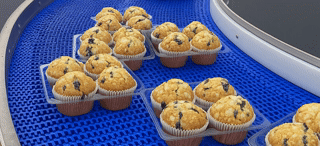Conveyor systems play a pivotal role in modern food processing and production lines. Acting as essential links between various stages, they ensure efficient, safe, and continuous material flow. Among these, food conveyors and belt conveyors stand out for their versatility and widespread use. Yet, many overlook a critical factor: conveyor belt speed. Conveyor speed isn’t a fixed parameter—it’s dynamic, influenced by various factors affecting production efficiency, product quality, energy use, and equipment wear.
In this article, we’ll explore the operational speed ranges of food conveyors, examine key factors affecting speed selection, and review common speed control methods. Understanding these principles will help businesses optimize their conveyor systems, boosting production efficiency, reducing costs, and ensuring food safety and quality.

Typical Conveyor Speed Ranges by Conveyor Type
Food conveyors and belt conveyors have varied speeds depending on their structure, application, and materials transported:
- Chain Plate Conveyors: Typically operate at 0–25 meters per minute, ideal for steady, precise handling of packaged products like bottles or boxes.
- Roller Belt Conveyors: Known for simplicity and easy maintenance, they run at lower speeds of about 0–15 meters per minute, ensuring stability and minimal rolling of materials.
- Standard Belt Conveyors: Widely used in food processing, they offer extensive speed flexibility, typically ranging:
- 0.8–4 meters/second (48–240 meters/minute) for sorting and packaging.
- 0–50 meters/minute specifically for food-grade mesh belt conveyors.
- 30–180 meters/minute for high-efficiency production lines.
- Spiral Freezer Conveyor Belts: Commonly operate at extremely low speeds (1–5 meters/hour) to allow sufficient freezing time, directly impacting food quality.
- Customized Applications: Precise, process-specific conveyors might run at unique speeds (e.g., 13–55 meters/minute) for delicate processing tasks.
Factors Influencing Conveyor Speed
Optimizing conveyor speed involves several critical considerations:
Material Characteristics
- Type: Powders, liquids, solids, and granules each require different speeds to maintain stability.
- Size and Shape: Larger or irregular items may need slower speeds to prevent instability and damage.
- Abrasiveness and Stickiness: Abrasive materials accelerate equipment wear, while sticky substances may accumulate, necessitating careful speed control.
Transport Distance and Capacity
- Distance: Longer conveyors may require higher speeds to maintain efficiency, though increased speed demands more robust equipment.
- Capacity: Higher throughput typically means higher speeds, but careful consideration is needed to avoid overloading or spillage.
Equipment Design and Structure
- Drive Systems: Electric motors, gearboxes, and variable frequency drives (VFDs) affect achievable speed ranges and control precision.
- Belt Material and Strength: Material choice (PVC, PU, rubber, Teflon) impacts load capacity, wear resistance, and permissible speed.
- Structural Stability: Robust frames and high-quality bearings are crucial for smooth, high-speed operation.
Application Environment and Process Requirements
- Process Needs: Operations like baking, cooling, freezing, or precise weighing demand exact speed settings.
- Discharge Methods: Certain unloading mechanisms may require lower speeds to reduce impact and wear.
- Safety Considerations: High speeds may increase the risk of spills, contamination, or injuries, necessitating careful planning.
- Energy and Cost Efficiency: Appropriate speed settings help balance energy consumption, operational efficiency, and maintenance costs.
Conveyor Speed Control Methods
Modern conveyors frequently use advanced methods like variable frequency drives (VFD) to adjust speeds flexibly and precisely. Mechanical methods such as gearboxes and pulley systems remain relevant for simpler applications where speed control precision is less critical.
Essential Food Conveyor Maintenance Practices
Effective maintenance ensures optimal conveyor performance and longevity:
- Regular inspection for belt alignment, wear, and tear.
- Thorough cleaning to maintain hygiene standards and prevent material buildup.
- Frequent lubrication of mechanical components to reduce friction.
- Routine checks and prompt repairs to prevent costly downtime.
- Training staff on proper conveyor usage and safety procedures.
Conclusion
Conveyor belt speed is crucial in food processing, directly affecting efficiency, product quality, safety, and cost management. Understanding how conveyor types, material properties, distances, equipment design, and process specifics affect optimal speeds enables smarter decisions. Incorporating proper speed control methods and proactive maintenance practices ensures reliable, efficient, and hygienic conveyor operations.
Optimize your production line today by applying these insights and maintaining your conveyor systems effectively.
Ready to Enhance Your Conveyor System Performance?
Contact us now for expert assistance on conveyor selection, speed optimization, and maintenance solutions tailored to your food production needs!

